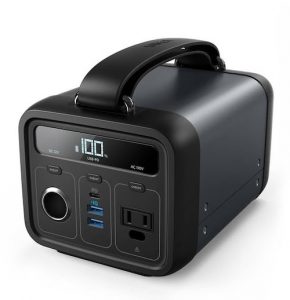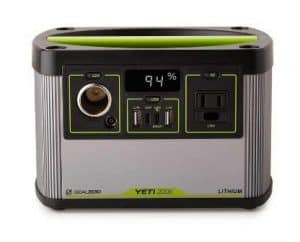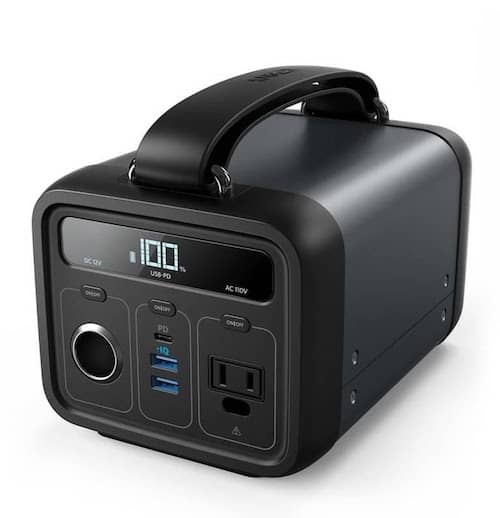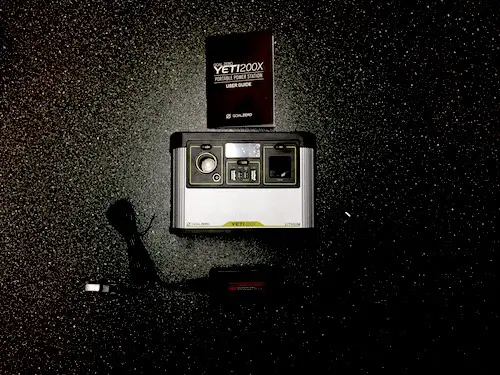With dozens of small solar generator options available today, I put a list together ranking the top models.
Below are my rankings as well as each model’s pros and cons.
| Ranking | Pros | Cons |
|---|---|---|
| 1. Best Overall – EcoFlow River 600 | – Powerful AC ports (600W continuous, 1,200W surge) – Can connect to smartphone via WiFi – Fast recharging times | – Expensive – Heavy (11 lbs) |
| 2. Best Value – Jackery Explorer 240 | – Inexpensive for its battery size – Lightweight (6.6 lbs) | – Only four output ports |
| 3. Best for Outdoors – Rockpals Rockpower 300 | – Port covers on 12V car port and AC port – 30W USB-C PD port – Can recharge from USB-C and wall at same time | – 12V outputs are not regulated |
| 4. Best Budget Option – Anker PowerHouse 200 | – USB-C PD port (30W max output, 60W max input) – Inexpensive – Lightweight (5.95 lbs) | – AC port can’t go over 100W |
| 5. Best USB Options – Goal Zero Yeti 200X | – 18W USB-C output and 60W USB-C PD input/output – Lightweight (5 lbs) | – Expensive |
The EcoFlow River 600 is the best small solar generator due to its high input/output power. It has robust AC ports (600W continuous, 1,200W surge) and takes 1.6 hrs (wall charger) and 1.6-3 hrs (solar) to fully recharge. The River can also double its battery capacity to 576Wh with an extra battery.
Below is a second table showing the solar generators we’ll be going over today along with their price range and battery size.
1. EcoFlow River 600
The River 600 is an expandable portable power station that is offered in multiple variants from EcoFlow, including the:
- River Mini
- River
- River Max
- River Pro
With a 288Wh battery, the River weighs in at 11 pounds. This is not lightweight when comparing it to similar solar generators.
For example, the Rockpals Rockpower 300 has a 280Wh battery yet weighs only 7.7 pounds.
However, the River 600 has impressive capabilities for a small system.
Features
The power station measures 11.4 x 7.3 x 7.7 inches. Its rectangular shape along with its carrying handle make it easy to carry.
You can also add a battery to the bottom of the River by removing four large screws and removing the bottom plate on the system. Adding this will double its capacity to 576Wh. At this stage, the River is now the River Max power station.
I own the River Max, and you can read my testing and review of it in my post found here: EcoFlow River 600 Review – Testing My River Max + Comparisons.
The River has ten total output ports, including:
- 3x AC ports (600W continuous, 1,200W surge)
- 1x USB-A Fast Charge port (18W max)
- 2x Standard USB-A outputs (12W max per port)
- 1x USB-C output (100W max)
- 2x DC5521 outputs
- 1x Car port (136W max)
Recharging
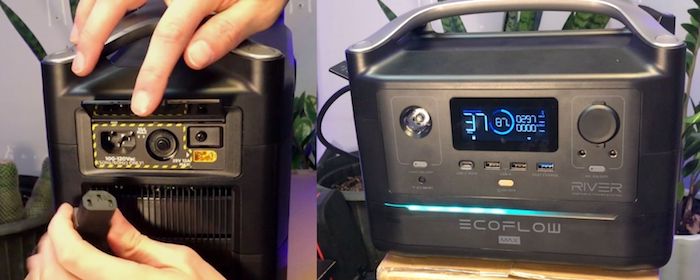
EcoFlow uses its patented X-STREAM technology to recharge from the wall faster than most other power stations of its size.
The River will recharge in 1.6 hours from its 250W (max) wall charger. If you add an additional battery to it, this doubles the recharging power to 500W maximum.
The River can fully recharge its battery from solar panels in the same amount of time it takes to charge from the wall due to its 200W maximum solar input.
Price
The retail price of the EcoFlow River ranges from $300-350 on Amazon.
Although this costs slightly higher compared to similar-sized systems from other brands, its ability to expand its battery, as well as its input and output power, are only found on this solar generator.
Similar: EcoFlow River 600 Review – Testing My River Max + Comparisons
2. Jackery Explorer 240

The Jackery Explorer 240 solar generator is one of the products from Jackery, a company founded in America, specializing in providing efficient and green power solutions for people worldwide.
As most of Jackery’s power stations go, the Explorer 240 is a rectangular portable power station shaped like a box, colored in the traditional Jackery colors of orange and grey.
Features
The product measures 5.2 by 9.1 by 7.7 inches, making it a sizeable yet, portably sized equipment. And contrary to the expectation of such a powerful system, it is relatively light for its size weighing only 6.6 lbs (approximately 3 kg).
This lightweight, in conjunction with a strong and compact handle built-in with the product, makes it very easy to move and carry about. It is a major point scored with campers and explorers and anyone intending to go out in the wild with this power station.
The ports available on the power station include a carport rated 12V, two USB ports, and a 3-prong AC outlet.
With a battery capacity of 240Wh, the Explorer 240 can charge your devices for a much longer duration than a typical power bank.
For example, the Explorer 240 can power the following:
- USB fan: 40+ hours
- Tablet: 7.5 recharges
- Smartphone: 24 recharges
- Laptop: 2 recharges
Recharging
The Jackery 240 can recharge from solar panels, an AC wall charger, and a 12V car charger. The solar panel recommended by Jackery for charging the power station is their SolarSaga 60W panel.
This solar panel is expected to fully charge the power station in 5.5 hours in good sunlight. The car charging method takes slightly less time at five hours, and the fastest recharging method comes from its wall charger, taking 3.5 hours to fully recharge.
Price
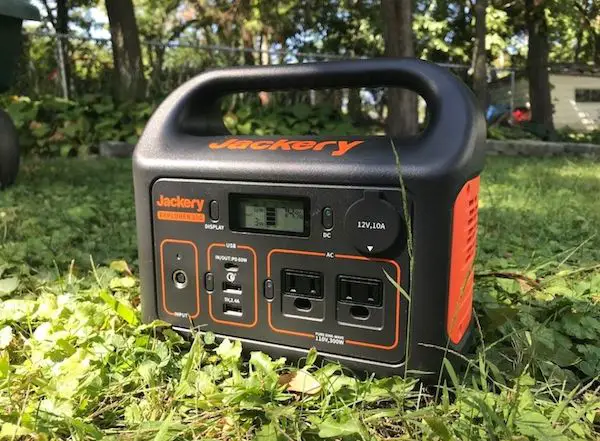
The retail price of the power station is $200 on Amazon. For the amount of battery life in the Jackery 240, this is a great price relative to other similar systems. However, it doesn’t have USB-C ports or USB-A fast-charging ports.
These options can be found in the slightly larger Jackery 300 model, which I have and have done a review on. You can read the results of my testing in my post here: Jackery Explorer 300 Review & Test (Plus Comparisons).
3. Rockpals Rockpower 300
The Rockpals Rockpower lineup consists of three portable power stations that are similar in their design but carry different battery sizes. These models include the:
- Rockpower 200
- Rockpower 300
- Rockpower 500
I own the Rockpower 500 and tested its capabilities in my review post found here: Rockpals Rockpower 500 Review (Testing, Pricing, and More).
Features
The Rockpals 300 comes in at 7.7 pounds with dimensions of 10.5 x 5.3 x 8.5 inches. It carries a 280Wh lithium-ion battery that is rated for 500 cycles to 80% capacity.
The outputs on the power station include:
- 1x AC port (300W continuous, 500W surge)
- 1x Car port (120W max)
- 2x DC5521 ports (60W max)
- 2x Standard USB-A ports
- 1x QC 3.0 USB-A
- 1x USB-C PD port (30W max)
The ports that stand out the most to me are the USB options. Having four different ones to work with allows you to charge multiple devices at once. Plus, the 30W USB-C can be used to charge larger devices like tablets and laptops.
Another feature that often gets overlooked is ruggedness.
The exterior shell of the Rockpals 300 is made from ABS plastic and is similar to other power stations, but the main features that are uncommon are its two output port covers – one over the 12V car port and one over the AC port.
These covers can be very effective at keeping dirt, dust, and any other particles out of these larger outputs especially when using the power station outdoors.
Recharging
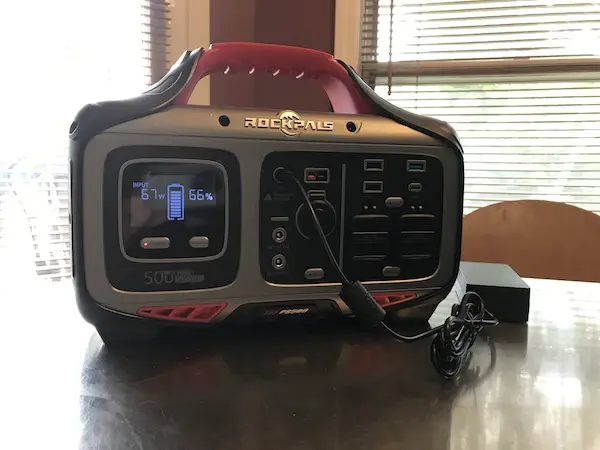
From the Rockpals 100W solar panel, the Rockpower 300 will recharge in 4.5-6.5 hours in good sunlight.
The AC charger that’s included in the package will take 4.5-5.5 hours to fully charge it up, while the car charger will take seven hours to recharge.
You can reduce the total charging from the wall charger by adding a USB-C charger. This will add 30W of power to the 72W wall charger and reduce the total recharging time to about 3.5 hours.
Price
The retail price of the Rockpals 300W power station ranges from $240-$285 on Amazon. This is a fair price when factoring in similar models.
If you want more power, you can do what I did and get the Rockpals 500 model, which adds over 200Wh of battery life compared to the Rockpals 300 model.
My review of the Rockpals 500 can be found here for more information: Rockpals Rockpower 500 Review (Testing, Pricing, and More).
4. Anker PowerHouse 200
Anker Powerhouse 200 has a sleek and streamlined build. Its edges are tapered and rounded, giving it a different look from the conventional rectangular box shape.
It is colored in jet black, although the tapes at the edges have a darker shade of the color.
Features
The powerhouse 200 measures a total of 7.7 by 5.5 by 4.7 inches, with a total weight of 5.95 lbs (2.7 kg).
With a battery capacity of 200Wh, the PowerHouse can recharge a typical smartphone about 25 times and a standard laptop 3-6 times over.
There are five ports on the power station:
- 1x AC port (100W max)
- 1x USB-C PD port (30W max output, 60W max input)
- 2x Fast charge USB-A ports
- 1x Car port (120W max)
There is an LED status indicator that shows the battery life and charging status of the power station. There are also switch buttons that can be used to control the functioning of these ports.
Recharging
The recharging options for the Anker PowerHouse 200 include charging through solar panels, wall outlets, car outlets, and via USB-C PD.
Charging through an AC wall outlet takes 6.5 hours, while USB-C charging takes 4.5 hours with 60W of power.
With a standard 60W solar panel, it will take 6-10 hours to recharge.
The Anker Powerhouse 200 also has a car charging port that can be used for a pass-through charging process.
This means that other devices can be charged through the power station while being charged with the car charging point.
However, care must be taken to ensure that the devices plugged in during the pass-through charging must not exceed the input gotten from the car.
If this happens, the power station itself will not get recharged.
Price
The retail price for the power station is around $160 on Amazon. At this price, the PowerHouse is cheaper than several similar options.
Similar: Goal Zero vs Anker – Which Company Reigns Supreme?
5. Goal Zero Yeti 200X
Over the years, Goal Zero has created a reputable and trusted brand in the world of sustainable energy.
Its products are well known for providing reliable and efficient green power solutions for people worldwide through its solar panels and portable power stations.
Among these products is the company’s smallest portable power station, the Yeti 200X.
Features
The Yeti 200X portable power station is built in the conventional rectangular shape that is true of most power stations.
Measuring a total of 7.9 by 5.1 by 5.1 inches (20 by 13 by 13 centimeters), it is a portable and suitably sized gadget. It comes with a comfortable and elegantly designed handle that makes it easier to move around.
The major point scored in the build of this device is its weight. This power station weighs in at five pounds (approximately 2.3 kilograms).
The Yeti 200X is regarded as the lightest of all the products in the Yeti series made by Goal Zero. Combined with its comfortable handle, it makes a great choice for campers and lovers of outdoor life.
Aesthetically, the Yeti 200X was built in a beautiful, yet rugged encasement. The body is made of anodized aluminum metal, its top and bottom painted black, and its handle in a fluorescent green color.
The top and bottom sections are made of rubbered plastic, while the mid-section is made of a metal casing.
The Yeti 200X comes with seven different output port options.
- 2x Standard USB-A (12W max)
- 1x USB-C (18W max)
- 1x USB-C PD (60W max)
- 1x Car port (120W max)
- 1x 12V 6mm port
- 1x AC port
Recharging
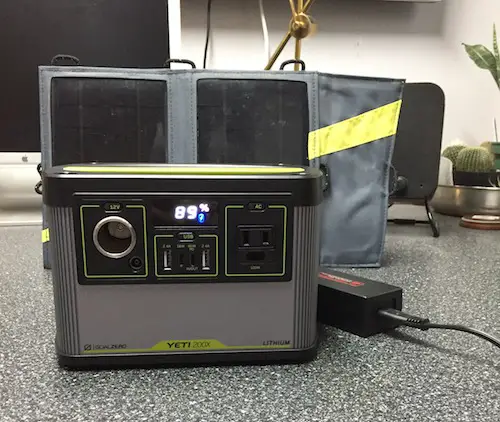
The Yeti 200X power station can be charged fully in 4.5 hours when plugged into a wall outlet.
The other options include charging through your 12V car port, an endeavor that takes only two hours to fully charge, and solar panels, whose duration depends on the capacity of the solar panel.
With a 50W panel, you can expect a four-hour recharge time.
Price
At a retail price of $299.95 on Amazon.com, the Yeti 200X is not a cheap product at all.
It is one of the most expensive power stations on the market for its size.
However, I added it to this list at the number five spot because it has the best USB port options for its size.
No other power station on this list has two USB-C outputs, and with more devices using this type of charging method, the Yeti 200X is ahead of the rest in terms of USB-C options.
You can read more on my experience with my Yeti 200X in my review post here: Goal Zero Yeti 200x Solar Powered Generator – Full Review.
How Much Does a Mini Solar Generator Cost?
The average cost of a mini solar generator between 160Wh and 300Wh is about $236. Within the same battery capacity parameters, a mini solar generator’s price ranges from about $110 to $400 depending on the model.
Below you’ll find ten different mini solar generators along with their battery size and price.
| Solar Generator Model | Battery Capacity | Cost |
|---|---|---|
| FlashFish 200W | 166Wh | $110 |
| Jackery Explorer 160 | 167Wh | $140 |
| Goal Zero Yeti 200X | 187Wh | $300 |
| EcoFlow River Mini (Wireless) | 210Wh | $350-400 |
| FlashFish 300W | 222Wh | $180 |
| Rockpals 200 | 224Wh | $170 |
| Jackery Explorer 240 | 240Wh | $200 |
| Rockpals 300 | 280Wh | $240-285 |
| EcoFlow River 600 | 288Wh | $300-350 |
| Jackery Explorer 300 | 293Wh | $300 |
From the table, the averages result in the following:
- Average battery capacity: 227.7Wh
- Average cost: $236.25
If you’re interested in one of these options, I recommend checking out my YouTube review of my EcoFlow River Max power station. It is nearly identical the the standard EcoFlow River except it has an additional battery on it.
Continue Reading:
Bluetti EB150 vs EcoFlow Delta 1300 – Which Solar Generator is Best?



